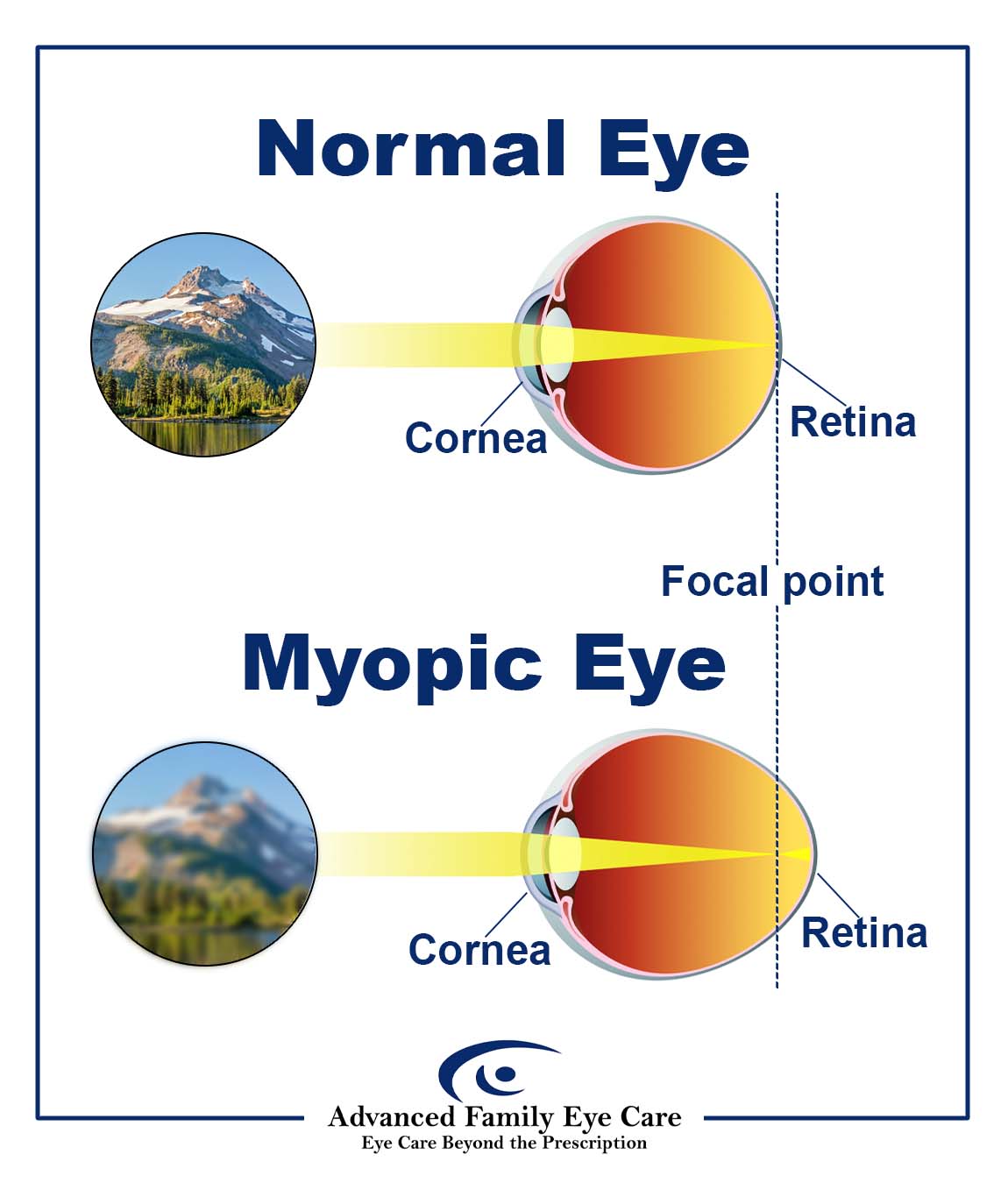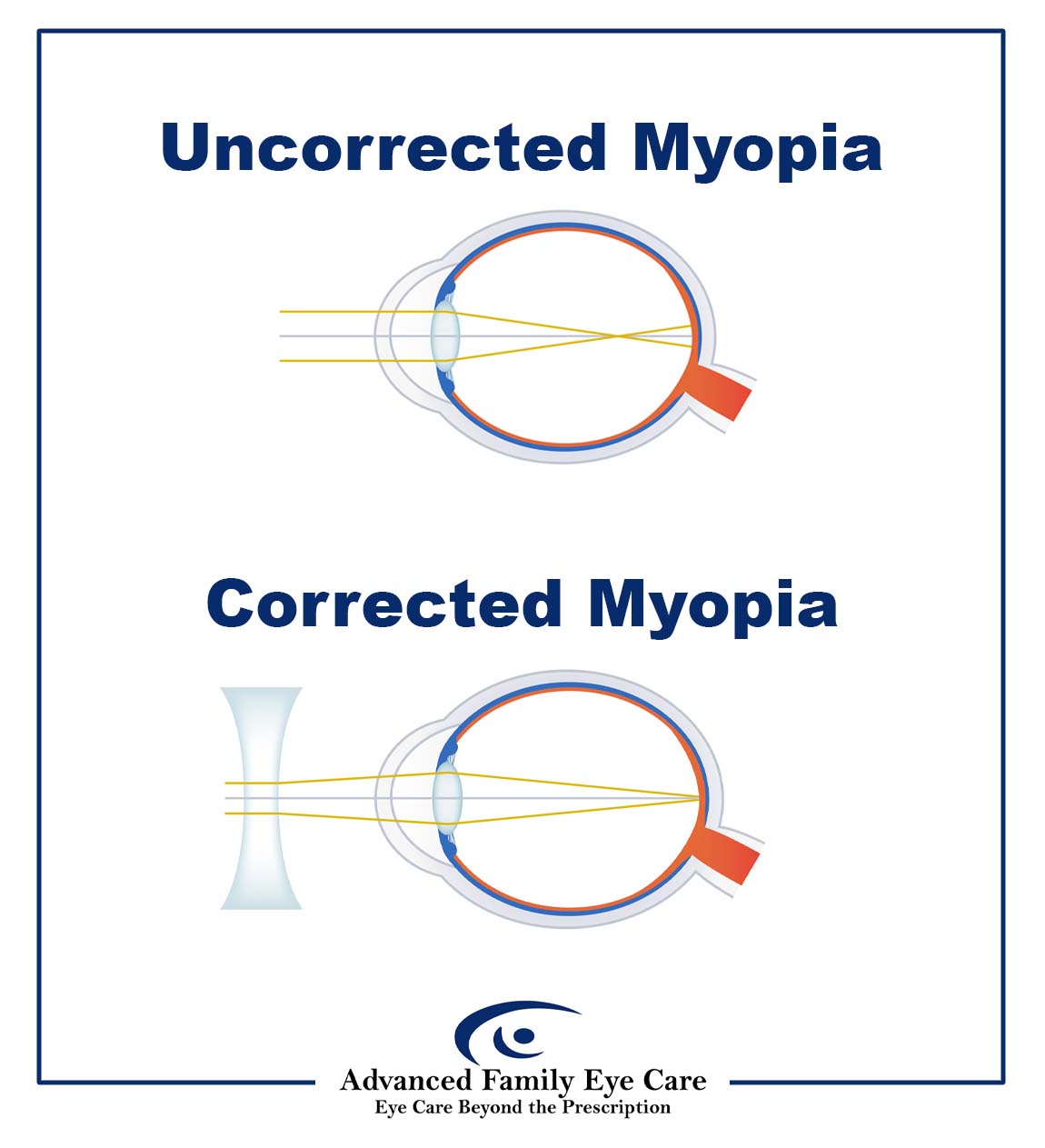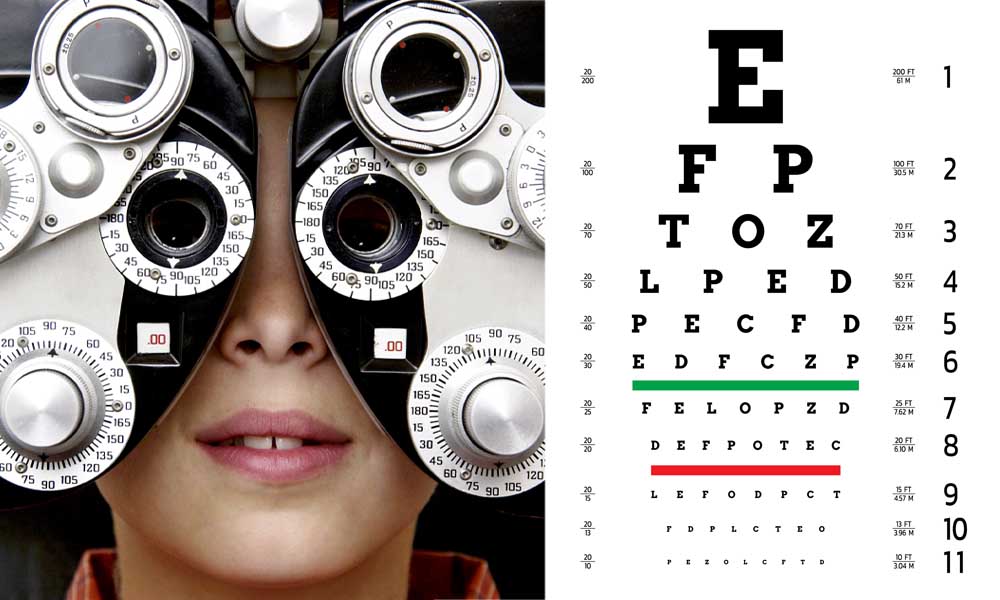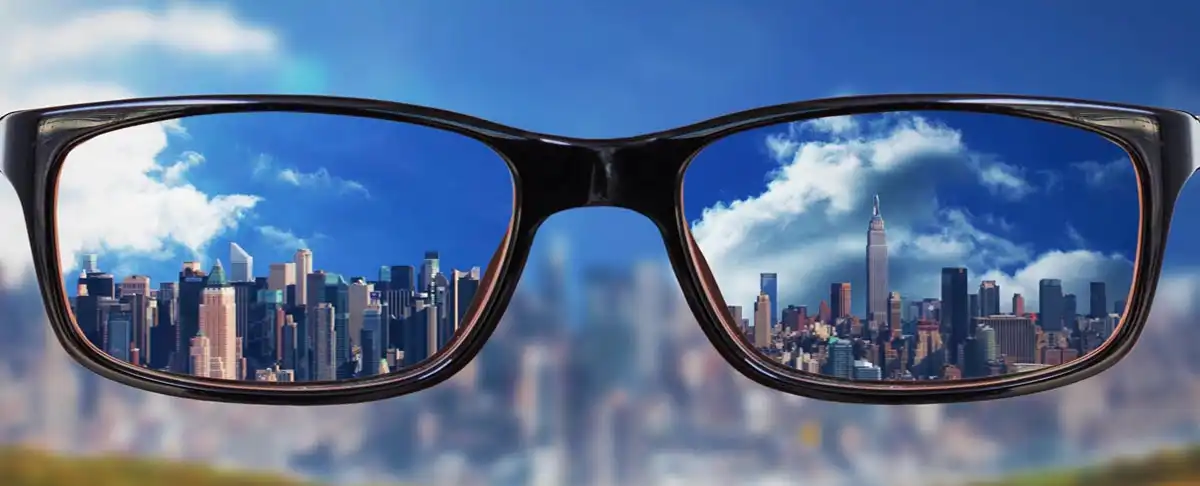Myopia (Nearsightedness) Q&A

Reviewed for accuracy by Brad Boyle, OD – Written by Advanced Family Eye Care staff on October 8, 2021 – Last edited on March 30, 2025
 Reviewed for accuracy by Brad Boyle, OD – Written by Advanced Family Eye Care staff on October 8, 2021 – Last edited on March 30, 2025
Reviewed for accuracy by Brad Boyle, OD – Written by Advanced Family Eye Care staff on October 8, 2021 – Last edited on March 30, 2025
Myopia, or nearsightedness, is a refractive error that affects the eye’s ability to see clearly from a distance. It is estimated that 1 in 3 Americans have myopia, and this rate is increasing.
From treatment to correction to everything in between, here’s what you need to know about this common condition.
What is myopia (nearsightedness)?
Myopia, or nearsightedness, is a refractive error resulting in the inability to see objects clearly from far away distances.
Individuals with myopia have no difficulty seeing clearly from close distances, but far away objects are blurry.
Nearsighted vs. farsighted – what’s the difference?
While nearsightedness (myopia) is characterized by the inability to see far away objects, farsightedness (hyperopia) is the inability to see objects clearly at close distances.
An easy way to remember is:
Nearsighted = No difficulty seeing objects that are near you (but difficulty seeing from far distances).
Farsighted = No difficulty seeing objects that are far away (but difficulty seeing from close distances).
In other words, the name characterizes what distance is seen clearly.
What causes myopia?
Myopia is caused by a misshaped eye – the eyeball is either too long, or the cornea (the clear outer layer of the eye) is curved too sharply. This affects the eye’s ability to bend (refract) light onto the retina.

With a normal eye, light is refracted onto the retina for a clear image at a distance. With myopia, the eye refracts light in front of the retina, resulting in blurred distant vision.
What are the risk factors for developing myopia?
The misshape in the eye that leads to myopia (nearsightedness) is believed to be caused by a combination of genetics and environmental factors.
Risk factors associated with its onset include:
- Genetics – Myopia may be inherited from your parents. If one or both of them have it, you are more likely to have it yourself.
- Health conditions – Certain health conditions such as diabetes can increase the risk for developing myopia.
- Up-close work – Studies have shown that intensive near work can lead to a higher prevalence of myopia. Examples of up close work include:
- Writing
- Reading
- Screen time (such as a phone or computer screen)
- Lack of time spent outdoors – It has been found that spending time outdoors can reduce the risk of myopia.
- Higher education – It has been found that those who attend college are more likely to develop myopia.
- Living in cities – Those residing in cities are more likely to have myopia than those in the countryside.
Does myopia worsen with age?
Myopia is usually diagnosed after the eye is done growing, between the age of 8 and 12. It will often get worse until about age 20, where its progression tends to plateau.
How common is myopia?
Myopia is among the most common eye conditions, affecting almost 30 percent of Americans, according to the American Optometric Association.
Why is myopia so common?
No one knows for sure why myopia is so common, but one hypothesis is from an evolutionary standpoint. If you think back to your middle school lesson on Charle’s Darwin’s natural selection, then you will remember that humans collectively develop traits over long periods of time to aid in survival.
Under this principle, our eyes would get better over time. However, since humans have developed effective myopia correction methods, being able to see at a far away distance is no longer important for survival. So rather than the eye evolving to see more clearly, it is doing the opposite.
In addition to nearly 1 in 3 people currently having myopia, it is increasing in prevalence. Some research predicts that almost half the world’s population will have myopia by the year 2050.
Why is myopia becoming more common?
Two possible reasons for an increase in the rates of myopia are an increase in close work (such as screen time) and a decrease in outside time – both of which have been found to increase the likelihood of myopia.
What are the symptoms of myopia?
- Blurred vision from a distance
- Difficulty performing tasks that involve distant viewing, such as driving, watching TV, or reading the board at school
- Squinting in order to see clearly from a distance
- Eyestrain
- Headaches
- Excessive blinking
- Frequent eye rubbing
Is myopia a disability?
Oxford languages defines a disability as a physical or mental condition that limits a person’s movements, senses, or activities.
Under this definition, you could technically call myopia a disability since it is an eye condition that limits your sense of sight.
However, myopia is so common and so effectively corrected that it is generally not considered a disability.
If you are wondering if you can get disability benefits for myopia (even severe cases) the answer is definitely no. Attorney Bethany K Laurence explains:
“For disability purposes, what matters is what your vision is while wearing glasses. Here’s why: You could have 20/800 vision without glasses (which is very low vision), but 20/20 vision with glasses. You would not have a disability.
On the other hand, if your eyesight, in both eyes, is 20/800 while wearing glasses (with a proper prescription), you would be automatically considered legally blind and could be eligible for Social Security disability.”
Is myopia a disease?
Myopia is generally not considered a disease for the same reason it is not considered a disability – it is so prevalent and so effectively corrected.
That’s not to say myopia can’t be serious. High degrees of myopia (also called “high myopia”) can increase the risk of certain sight-threatening eye diseases such as glaucoma and retinal detachment.
Can myopia lead to blindness?
In rare cases, high myopia can lead to more severe eye problems when left untreated – including blindness. This type of myopia is called degenerative myopia.
For this reason, it is important to receive regular eye exams so your eye doctor can catch any sort of complications early.
How bad is my myopia?
The level of severity of myopia is measured by the amount of correction it requires. The unit of measurement for the focusing power of a lens is diopters (D).
The types of myopia are classified by level of severity as follows:
- Mild myopia: -0.25 to -3.00 D
- Moderate myopia: -3.25 to -5.00 D or -6.00 D
- High myopia: greater than -5.00 D or -6.00 D
Mild and moderate myopia may also be collectively referred to as simple myopia (-.025 to -6.00 D). Simple myopia is the most common form of myopia. Moderate to high myopia is sometimes associated with a more severe case of myopia, called degenerative myopia. Degenerative myopia (also called progressive myopia and pathological myopia) is characterized by the worsening at an above average rate and blurry vision even after correction. Degenerative myopia is a serious condition that can sometimes lead to blindness.
So how bad is your myopia? If you wear contact lenses, you are in luck. Simply check the packaging. Look for the letters “D”, “pwr”, or “sph” followed by a negative number:

The above example shows myopic contact lenses requiring 2 diopters of correction (D -2.00). A person prescribed these lenses would have mild myopia, since it is less than 3.
If you wear glasses, a quick call to your eye doctor can confirm how many diopters your prescription has. If calling the doctor is not an option, you can check out this article that discusses alternative methods for looking up your eyeglass prescription.
How is myopia (nearsightedness) corrected?
Myopia can be corrected with eyeglasses, contact lenses, or refractive surgery.
Eyeglasses and contact lenses both utilize concave shaped lenses, meaning they are thicker at the edges than they are in the center. This concave shape works by counteracting the refraction error caused by the misshaped eye, allowing light to focus on the retina instead of in front of it.

Myopia correction with refractive surgery involves surgically reshaping the cornea to counteract the refraction error. There are several myopia surgery options, including LASIK and PRK. It is important to weigh the pros and cons of each option and thoroughly discuss options with your surgeon prior to making a decision.
Can you fix nearsightedness naturally?
While you can’t “fix” or reverse myopia naturally, research suggests that several environmental factors including lack of time outside and close work (such as staring at a phone or computer screen) can increase the prevalence and severity of myopia.
Here are some things that may naturally help your myopia:
- Limit nearby screen time (as with phones or computer screens)
- Get outside
- Exercise
- Eat a balanced diet rich in eye-enhancing nutrients
- Get regular eye exams
Can you have myopia in one eye?
Yes. The term for refractive errors involving eyes with varying refractive powers is anisometropia. Those with one myopic eye and one normal eye would have a case of simple anisometropia. Those with one myopic (nearsighted) eye and one hyperopic (farsighted) eye would have mixed anisometropia.
How is myopia diagnosed?
Myopia is diagnosed with refraction assessment during a basic eye exam. With a refraction assessment, the patient looks at an array of letters through a special device called a phoropter, which contains lenses with differing strengths (diopters).

Your eye doctor will rotate through the lenses, asking you to specify the clarity of what you see until the optimal correction level has been determined. Patients requiring greater than -0.25 diopters of correction will be considered myopic, although correction generally is not required unless -1.00 diopters or greater are indicated.
Do I have myopia?
If you are experiencing any of the symptoms of myopia such as trouble reading traffic signs, trouble reading the board at school, or general difficulty seeing from afar, then there is a good chance you have myopia. Only a doctor can tell you for sure and make sure your symptoms are not associated with a more serious eye condition, so it is important to get regular eye exams.
Conclusion
Myopia (nearsightedness) is a common eye condition caused by a misshaped eye that results in an inability to see clearly at a distance. It can be corrected with contact lenses, glasses, or surgery.
Regular eye exams are important for the diagnosis and treatment of myopia and other eye disorders. If you think you may have new or worsening myopia, you want to see an eye doctor right away.
For those in the Cedar Valley, Iowa area, click here to be seen by us within 1 week or your exam is on us!






